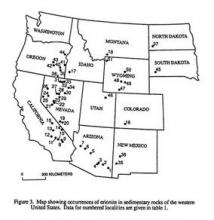Lung screening was offered to Dunn County residents exposed to erionite, but only 34 residents, including gravel pit and road maintenance workers, enrolled in the study. A significant increase in interstitial changes above background prevalence was observed on high-resolution computed tomography in 17.6% of residents, compared with 1.5% for male urban transportation workers with low cumulative asbestos fiber exposure, Dr. Carbone said.
Transmission electron microscopy (TEM) revealed higher total concentrations of erionite fibers in air samples taken street-side in Dunn County (mean 0.108 structures per cubic centimeter [s/cc]) than from samples taken from the streets of five Turkish villages including Boyali (mean 0.00 s/cc), he said. Total TEM erionite concentrations were also higher indoors in Dunn County than in Boyali (mean 0.175 s/cc vs. 0.043 s/cc).
Research in Turkey has shown that increased industrialization significantly increases airborne particulates, an observation that is particularly worrisome since oil production activity has increased road traffic in Dunn County and development has grown in states such as Nevada where erionite deposits are far more common than in North Dakota.
Equally worrisome is that unlike asbestos, erionite has no current health benchmarks nor is it regulated by the U.S. Environmental Protection Agency or other agencies, Dr. Miller said. "The horse is out of the barn for some, but I think we can do a lot more to protect others," he said. "You can’t ban a natural substance, but I’d certainly like to see contaminated materials and disturbance of problem areas managed more effectively."
Dr. Carbone stressed the need to reduce erionite exposure, but is also working to isolate mesothelioma-susceptibility genes that might help to explain the pathogenesis of the disease and to identify high-risk patients for early treatment. The U.S. Early Detection Research Network, a branch of the National Cancer Institute, has funded a clinical trial that is prospectively evaluating osteopontin and mesothelin as early markers for the detection of mesothelioma. The 800-patient trial is expected to begin in 2011 and to be completed sometime in 2014, said Dr. Carbone, its coprincipal investigator together with thoracic surgeon Dr. Harvey I. Pass, professor and chief of the thoracic surgery division at New York University’s Langone Medical Center in New York City.
Dr. Carbone and his team are also looking to identify some point in the evolution of mesothelioma process that is vulnerable to intervention. Dr. Haining Yang, now also at the University of Hawaii Cancer Center, was the first author of a previous report that tumor necrois factor–alpha inhibits asbestos-induced cytotoxicity via a nuclear factor-kappa B-dependent mechanism that increases the percentage of human mesothelial cells that survive asbestos exposure, thus increasing the pool of asbestos-damaged cells susceptible to malignant transformation (Proc. Natl. Acad. Sci. USA. 2006;103:10397-402).
In tissue culture, North Dakota, Oregon, and Turkish erionite have been found to induce high-mobility group protein B1 (HMGB1) and TNF-alpha release from human mesothelial cells and macrophages, Dr. Yang et al also reported. When coupled with chronic inflammation of the peritoneum and pleura, HMGB1 and TNF-alpha release have been linked to malignant mesothelioma in mice and in humans (Proc. Natl. Acad. Sci. USA, 2010;107:12611-6).
Dr. Carbone called for a larger, more detailed epidemiologic survey of the health implications of erionite in North Dakota, as was performed for Libby, and said that it should include mine and road workers with direct exposure as well as adults and children with environmental exposure. This also should include correlative studies that exploit recent findings regarding biomarkers involved in fiber carcinogenesis, as is being done in Libby, he said.
The study was partially funded by a National Cancer Institute investigator grant. Dr. Carbone and Dr. Miller reported no conflicts of interest. Coauthors report funding from Rosetta Genomics, Celera, Soma Logic, and SourceMDX and a leadership role in the American College of Radiology Imaging Network.

